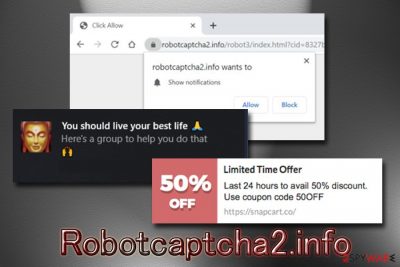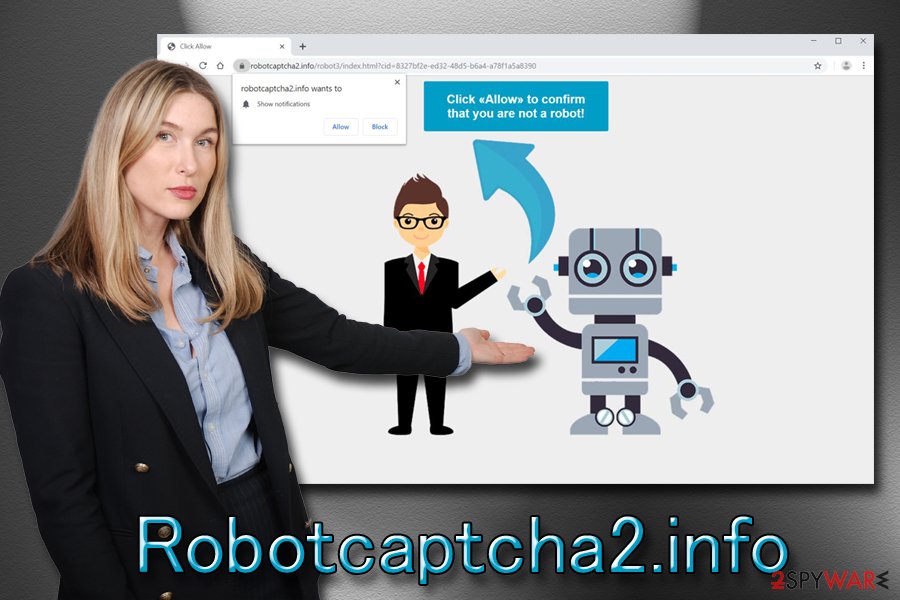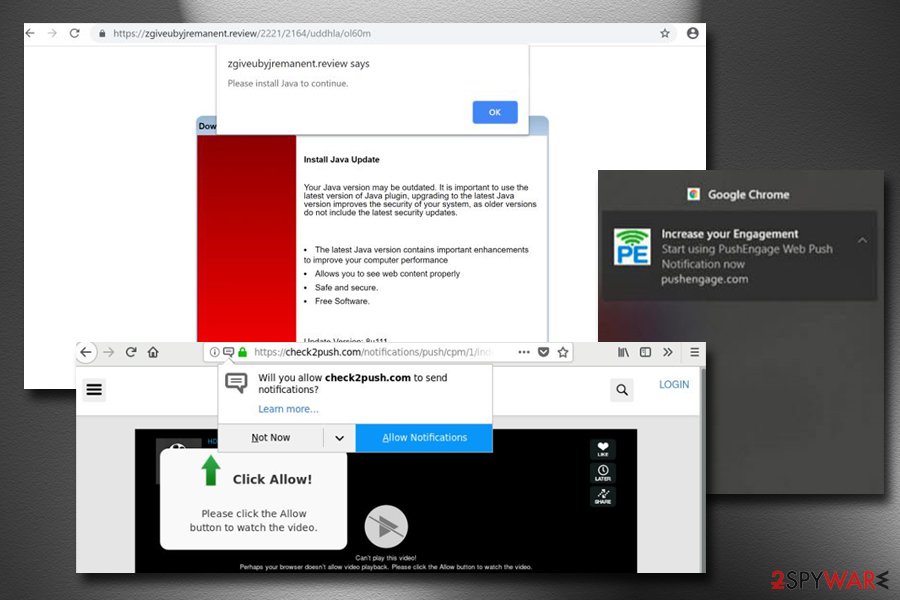Robotcaptcha2.info (Virus Removal Instructions) - Chrome, Firefox, IE, Edge
Robotcaptcha2.info Removal Guide
What is Robotcaptcha2.info?
Robotcaptcha2.info is a push notification virus that inserts intrusive links and adverts directly into the desktop

Robotcaptcha2.info is a redirect and push notification virus that targets users who are less attentive during the installation process of the freeware. The campaign is usually associated with adware[1] – a potentially unwanted application that is designed to monitor users' online behavior, redirect them to affiliated sites and display sponsored content on Google Chrome, Safari, Mozilla Firefox, Internet Explorer, Opera, or another browser.
Ad-supported software does not only displays ads that relate to trustworthy affiliates but also phishing, scam, and sites like Robotcaptcha2.info. Once users land on the site, they are asked to allow the notifications to be shown to enable the alleged underlying content. As soon as the permission is granted, users will be faced with Robotcaptcha2.info ads, pop-ups that spawn directly on the screen and other activities.
| Name | Robotcaptcha2.info |
| Type | Push notification virus |
| Category | Adware |
| Symptoms | Intrusive ads appearing directly on the desktop, redirects to suspicious sites, slow operation of the browser, etc. |
| Risk factors | Loss of money, malware intrusion, installation of potentially unwanted programs, personal details disclosure to unknown parties |
| Distribution | Software bundles, third-party sites, ads |
| Elimination | To remove adware along with Robotcaptcha2 redirects, scan your device with FortectIntego or another security software |
| Alternative method | You can uninstall the unwanted application manually by following our guide below |
However, push notification viruses are simply domains on the internet, so if you landed on one that does not necessarily mean that adware is involved. If that's the case, Robotcaptcha2.info removal can be performed by resetting the browser or denying notifications from a particular site via the browser settings.
Upon arrival to the site, Robotcaptcha2 will display the following notification, but no background content which in reality does not even exist:
Click Allow to confirm that you are not a robot!
As evident, this is a scam and a clever way to pursue users to allow Robotcaptcha2.info notifications to be shown.
The purpose of Robotcaptcha2 is to display you ads which, once clicked, generate revenue for the third-parties. However, this activity is not always too safe, as adware developers do not check the content they might be linking you to, so they take no responsibility for any misconduct, such as malware infection, sensitive data disclosure, and similar.
Robotcaptcha2.info virus might lead you to phishing, spoofing,[2] or technical support scam[3] sites. Due to lack of experience, a lot of people fall for social engineering tricks used by cybercriminals and allow them to control their machines remotely, disclose credit card or other details, or enter a website where malware is downloaded and installed automatically.

Therefore, seemingly insignificant adware infection that leads you to Robotcaptcha2.info might end up damaging your computer system by altering it or installing more serious threats. In the worst-case scenario, the exposed sensitive data might be used to commit fraud, identity theft, and corrupt credit score.[4]
Therefore, never click on any content that comes from unknown sources or sites you got redirected to. Simply close down your browser and remove Robotcaptcha2 from your computer with FortectIntego or another security software. Another way to stop the intrusive content is by uninstalling the adware app manually, although its detection might sometimes be complicated.
Do not install allegedly useful apps without finding out more about them
There are three ways adware can get installed on the host machine:
- Comes bundled together with free software from third-party sites
- Is installed intentionally without users realizing its true purpose
- Attractive or scam ads/pop-ups on the internet
Software bundling, being the most prevalent adware distribution method, should be paid attention to the most. Many free software distribution sites often use an installation executable that is induced with optional components. To avoid them, simply decline all the deals or offers on the way, and always opt for Advanced/Custom installation settings rather than the Recommended/Quick ones.

The “voluntary” installs can be prevented by researching the application beforehand. For example, if you are looking for software that can convert your files from PDF to a text document, do not just download whatever comes your way. Read some reviews and forum posts – they often hind about the dodgy nature of the app.
Finally, do not download any type of software that is suggested on the scam sites – these often claim malware infections and then push PUPs like fake system optimizers or rogue anti-spyware.
All in all, it all comes down to being attentive while browsing the internet and using adequate security tools to prevent the intrusion of potentially unwanted programs and malware.
Robotcaptcha2.info ads and redirects can be stopped – here's how to do it
There are two ways you can remove Robotcaptcha2.info virus from your machine. You need to either terminate the adware that is linking you to the malicious site or prevent notifications from being shown via the browser settings. It all depends on whether your machine is infected with adware.
If that is the case, you should scan your PC with anti-malware software and delete all the unwanted apps along with malware without putting much thought into it. However, if you suspect or know which program might be ad-supported, you can also perform Robotcaptcha2 removal manually – check out the details below.
If your computer is not infected, however, you can simply stop notifications from being shown from a particular website. To do that, follow these steps:
Google Chrome
- Open Chrome and select Menu
- Pick Settings
- Go to Advanced > Privacy and security > Site Settings > Notifications
- Under Allow, you should be able to see Robotcaptcha2.info entry
- Click on More Actions and then select Block
Mozilla Firefox:
- Start up Firefox and click on the Menu
- Select Options
- Go to Privacy & Security and then pick Notifications
- Choose Settings to locate Robotcaptcha2.info
- Next to it, click on the drop-down menu and pick Block
Safari:
- Go to Safari and then click on Preferences
- Select Notifications
- Locate Robotcaptcha2.info and pick Deny
MS Edge:
- Go to More > Settings
- Select View advanced settings
- Find Robotcaptcha2.info and turn off notifications
You may remove virus damage with a help of FortectIntego. SpyHunter 5Combo Cleaner and Malwarebytes are recommended to detect potentially unwanted programs and viruses with all their files and registry entries that are related to them.
Getting rid of Robotcaptcha2.info. Follow these steps
Uninstall from Windows
You should perform these steps on Windows OS if adware is installed on your computer:
Instructions for Windows 10/8 machines:
- Enter Control Panel into Windows search box and hit Enter or click on the search result.
- Under Programs, select Uninstall a program.

- From the list, find the entry of the suspicious program.
- Right-click on the application and select Uninstall.
- If User Account Control shows up, click Yes.
- Wait till uninstallation process is complete and click OK.

If you are Windows 7/XP user, proceed with the following instructions:
- Click on Windows Start > Control Panel located on the right pane (if you are Windows XP user, click on Add/Remove Programs).
- In Control Panel, select Programs > Uninstall a program.

- Pick the unwanted application by clicking on it once.
- At the top, click Uninstall/Change.
- In the confirmation prompt, pick Yes.
- Click OK once the removal process is finished.
Delete from macOS
macOS users should follows the following instructions to remove Robotcaptcha2.info fully:
Remove items from Applications folder:
- From the menu bar, select Go > Applications.
- In the Applications folder, look for all related entries.
- Click on the app and drag it to Trash (or right-click and pick Move to Trash)

To fully remove an unwanted app, you need to access Application Support, LaunchAgents, and LaunchDaemons folders and delete relevant files:
- Select Go > Go to Folder.
- Enter /Library/Application Support and click Go or press Enter.
- In the Application Support folder, look for any dubious entries and then delete them.
- Now enter /Library/LaunchAgents and /Library/LaunchDaemons folders the same way and terminate all the related .plist files.

Remove from Microsoft Edge
Delete unwanted extensions from MS Edge:
- Select Menu (three horizontal dots at the top-right of the browser window) and pick Extensions.
- From the list, pick the extension and click on the Gear icon.
- Click on Uninstall at the bottom.

Clear cookies and other browser data:
- Click on the Menu (three horizontal dots at the top-right of the browser window) and select Privacy & security.
- Under Clear browsing data, pick Choose what to clear.
- Select everything (apart from passwords, although you might want to include Media licenses as well, if applicable) and click on Clear.

Restore new tab and homepage settings:
- Click the menu icon and choose Settings.
- Then find On startup section.
- Click Disable if you found any suspicious domain.
Reset MS Edge if the above steps did not work:
- Press on Ctrl + Shift + Esc to open Task Manager.
- Click on More details arrow at the bottom of the window.
- Select Details tab.
- Now scroll down and locate every entry with Microsoft Edge name in it. Right-click on each of them and select End Task to stop MS Edge from running.

If this solution failed to help you, you need to use an advanced Edge reset method. Note that you need to backup your data before proceeding.
- Find the following folder on your computer: C:\\Users\\%username%\\AppData\\Local\\Packages\\Microsoft.MicrosoftEdge_8wekyb3d8bbwe.
- Press Ctrl + A on your keyboard to select all folders.
- Right-click on them and pick Delete

- Now right-click on the Start button and pick Windows PowerShell (Admin).
- When the new window opens, copy and paste the following command, and then press Enter:
Get-AppXPackage -AllUsers -Name Microsoft.MicrosoftEdge | Foreach {Add-AppxPackage -DisableDevelopmentMode -Register “$($_.InstallLocation)\\AppXManifest.xml” -Verbose

Instructions for Chromium-based Edge
Delete extensions from MS Edge (Chromium):
- Open Edge and click select Settings > Extensions.
- Delete unwanted extensions by clicking Remove.

Clear cache and site data:
- Click on Menu and go to Settings.
- Select Privacy, search and services.
- Under Clear browsing data, pick Choose what to clear.
- Under Time range, pick All time.
- Select Clear now.

Reset Chromium-based MS Edge:
- Click on Menu and select Settings.
- On the left side, pick Reset settings.
- Select Restore settings to their default values.
- Confirm with Reset.

Remove from Mozilla Firefox (FF)
To reset all the settings on Mozilla Firefox that adware might have altered, please follow these instructions:
Remove dangerous extensions:
- Open Mozilla Firefox browser and click on the Menu (three horizontal lines at the top-right of the window).
- Select Add-ons.
- In here, select unwanted plugin and click Remove.

Reset the homepage:
- Click three horizontal lines at the top right corner to open the menu.
- Choose Options.
- Under Home options, enter your preferred site that will open every time you newly open the Mozilla Firefox.
Clear cookies and site data:
- Click Menu and pick Settings.
- Go to Privacy & Security section.
- Scroll down to locate Cookies and Site Data.
- Click on Clear Data…
- Select Cookies and Site Data, as well as Cached Web Content and press Clear.

Reset Mozilla Firefox
If clearing the browser as explained above did not help, reset Mozilla Firefox:
- Open Mozilla Firefox browser and click the Menu.
- Go to Help and then choose Troubleshooting Information.

- Under Give Firefox a tune up section, click on Refresh Firefox…
- Once the pop-up shows up, confirm the action by pressing on Refresh Firefox.

Remove from Google Chrome
Delete malicious extensions from Google Chrome:
- Open Google Chrome, click on the Menu (three vertical dots at the top-right corner) and select More tools > Extensions.
- In the newly opened window, you will see all the installed extensions. Uninstall all the suspicious plugins that might be related to the unwanted program by clicking Remove.

Clear cache and web data from Chrome:
- Click on Menu and pick Settings.
- Under Privacy and security, select Clear browsing data.
- Select Browsing history, Cookies and other site data, as well as Cached images and files.
- Click Clear data.

Change your homepage:
- Click menu and choose Settings.
- Look for a suspicious site in the On startup section.
- Click on Open a specific or set of pages and click on three dots to find the Remove option.
Reset Google Chrome:
If the previous methods did not help you, reset Google Chrome to eliminate all the unwanted components:
- Click on Menu and select Settings.
- In the Settings, scroll down and click Advanced.
- Scroll down and locate Reset and clean up section.
- Now click Restore settings to their original defaults.
- Confirm with Reset settings.

Delete from Safari
Remove unwanted extensions from Safari:
- Click Safari > Preferences…
- In the new window, pick Extensions.
- Select the unwanted extension and select Uninstall.

Clear cookies and other website data from Safari:
- Click Safari > Clear History…
- From the drop-down menu under Clear, pick all history.
- Confirm with Clear History.

Reset Safari if the above-mentioned steps did not help you:
- Click Safari > Preferences…
- Go to Advanced tab.
- Tick the Show Develop menu in menu bar.
- From the menu bar, click Develop, and then select Empty Caches.

After uninstalling this potentially unwanted program (PUP) and fixing each of your web browsers, we recommend you to scan your PC system with a reputable anti-spyware. This will help you to get rid of Robotcaptcha2.info registry traces and will also identify related parasites or possible malware infections on your computer. For that you can use our top-rated malware remover: FortectIntego, SpyHunter 5Combo Cleaner or Malwarebytes.
How to prevent from getting adware
Do not let government spy on you
The government has many issues in regards to tracking users' data and spying on citizens, so you should take this into consideration and learn more about shady information gathering practices. Avoid any unwanted government tracking or spying by going totally anonymous on the internet.
You can choose a different location when you go online and access any material you want without particular content restrictions. You can easily enjoy internet connection without any risks of being hacked by using Private Internet Access VPN.
Control the information that can be accessed by government any other unwanted party and surf online without being spied on. Even if you are not involved in illegal activities or trust your selection of services, platforms, be suspicious for your own security and take precautionary measures by using the VPN service.
Backup files for the later use, in case of the malware attack
Computer users can suffer from data losses due to cyber infections or their own faulty doings. Ransomware can encrypt and hold files hostage, while unforeseen power cuts might cause a loss of important documents. If you have proper up-to-date backups, you can easily recover after such an incident and get back to work. It is also equally important to update backups on a regular basis so that the newest information remains intact – you can set this process to be performed automatically.
When you have the previous version of every important document or project you can avoid frustration and breakdowns. It comes in handy when malware strikes out of nowhere. Use Data Recovery Pro for the data restoration process.
- ^ Olivia Morelli. What is adware? In depth analysis and removal guides. 2-spyware. Cybersecurity news and articles.
- ^ Spoof Website. Techopedia. Where IT and Business Meet.
- ^ Protect yourself from tech support scams. Microsoft. Windows Security Support.
- ^ Information security: How Hackers Leverage Stolen Data for Profit. Trend Micro. Cybersecurity blog.























